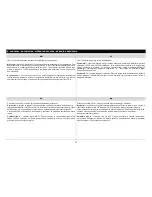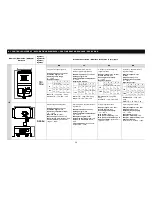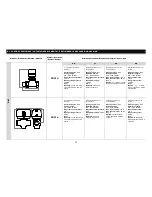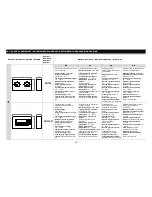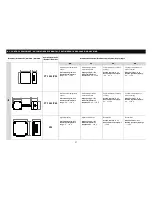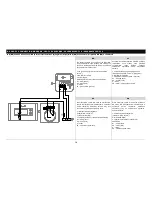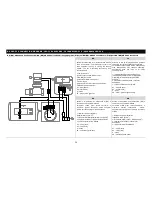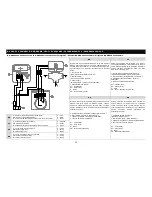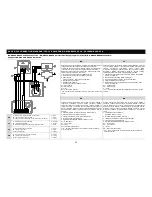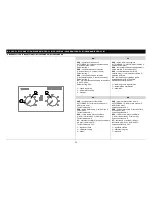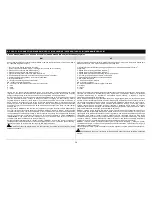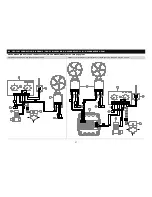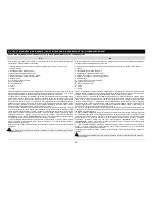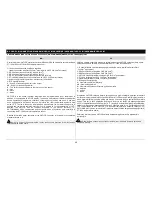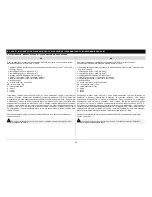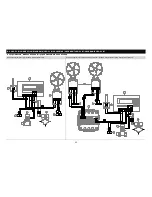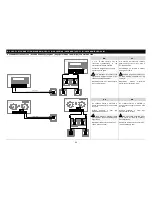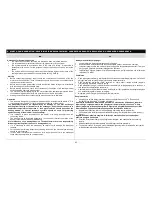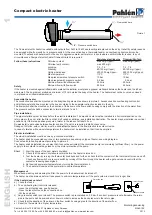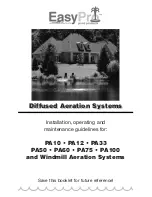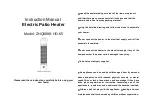
36
8.3. LEO FL M CONNECTION DIAGRAMS | LEO FL M VALDYMAS | OVLÁDÁNÍ LEO FL M | OVLÁDANIE LEO FL M
VNT20, SRV2d (SRV3d) and PT-1000 Connection | VNT20, SRV2d (SRV3d) bei PT-1000 pajungimas
EN
LT
Control elements: VNT20 controller, optional SRV2d or SRV3d valve with actuator and PT-1000 IP20 or
PT-1000 IP65 temperature sensor.
fan junction box located outside on the cable
(power connection with OMY 3x1mm
2
, steering with LIYCY 2x0,5mm
2
screened)
SRV2d valve (connection with OMY 2x0,5mm
2
)
SRV3d valve (connection with OMY 3x0,5mm
2
)
VNT20 controller (power connection with OMY 2x1mm
2
)
PT-1000 temperature sensor (connection with LIYCY 2x0,5mm
2
screened)
power supply (switching s disconnector) 230V/50Hz
R10 signal distributor
A – Supply of the heating medium to the heater
AB – Supply of the heating medium
B – The exit of the heat medium to the return line of the heater
a – blue
b – black
c – brown
VNT20 is a fan speed regulator integrated with a room thermostat. It features automatic fan speed
regulation in function of the temperature. PI regulator automatically reduces the device airflow, and thus
energy consumption and noise level, when the set room temperature is being approached
During control in AUTO mode the speed is regulated automatically and smoothly on the basis of a signal
from the temperature sensor. Change of the airflow results in changing the heat capacity. Either a
separate valve with actuator for every heater or one valve for all heaters may be used in this mode. In
AUTO mode it is not necessary to use valves. In this case the heating medium is regulated by the boiler
automatic system. The speed regulation knob is inactive in AUTO mode (setting it to minimum switches
off the fan control). The minimum speed in AUTO mode may be changed in the range of 0-60% (default
setting to 30%).
During control in MANUAL mode the room thermostat and the speed controller operate independently.
The room thermostat controls the operation of the SRV2 or SRV3d valve with actuator, while the speed
controller controls the fan. The room temperature is thus controlled by the thermostat which switches the
valve depending on the thermostat setting. In this case the fan is operating at a constant speed set by the
user for the entire time of operation of the device. This mode of operation is called „continuous”.
„Thermostatic” mode means that after reaching the set room temperature the device is switched off
completely (the valve is closed and the fan is switched off).
Setting the speed regulation knob to „standby” position in MANUAL control mode results in switching off
the fan while the thermostat continues to control the valves operation. This is protection against freezing.
The VNT20 controls up to 10 devices (thorough the R10 signal distributor).
In order to increase the general safety, the fan connection is executed in the junction box located
outside on the cable.
Valdymo sistem
ą
sudaro šie elementai: VNT20 valdymo panelis bei, kaip opcija, vožtuvas su SRV2d abra
SRV3d servovarikliu, o taip pat PT-1000 IP20 abra PT-1000 IP65.
iš kabelio išvesta ventiliatoriaus pajungimo kabelin
÷
mova, (maitinimo šaltinio OMY 3x1mm
2
prijungimas)
SRV2d vožtuvas (prijungimas OMY 2x0,5mm
2
)
SRV3d vožtuvas (prijungimas OMY 3x0,5mm
2
)
VNT20 valdiklis (maitinimo šaltinio OMY 2x1mm
2
prijungimas)
PT-1000 (prijungimas LIYCY 2x0,5mm
2
ekranuotas)
maitinimas (skirstomoji d
÷
ž
÷
+ skyriklis) 230V/50Hz
R10 signalo skirstytuvas
A – šilumnešio
į
vedimas
į
šildytuv
ą
AB – šilumnešio
į
vedimas
B – šilumnešio iš
÷
jimas ant šildytuvo gr
į
žimo vamzdžio
a – m
÷
lynas
b – juodas
c – rudas
VNT20 tai su patalpos termostatu integruotas ventiliatoriaus sukimosi grei
č
io reguliatorius. Temperat
ū
ros
funkcijoje yra automatinis ventiliatoriaus grei
č
io reguliavimas. Temperat
ū
rai art
÷
jant prie patalpoje
nustatytos temperat
ū
ros, PI reguliatorius automatiškai mažina našum
ą
, o vadinasi ir
į
renginio
triukšmingum
ą
bei energijos sunaudojim
ą
.
AUTO režime sukimosi greitis yra reguliuojamas savaime, tolygiai pagal signal
ą
, kur
į
duoda temperat
ū
ros
daviklis. Kei
č
iant ventiliatoriaus našum
ą
, kei
č
iasi šildymo galia temperat
ū
r
ų
skirtumo funkcijoje. Šiame
režime galima pasinaudoti atskiru vožtuvu su servovarikliu kiekvienam šildytuvui arba vienu vožtuvu,
skirtu visiems šildytuvams. AUTO režime neb
ū
tina naudoti SRV2d vožtuv
ų
. Tokiu atveju vandens
šildym
ą
reguliuoja katilo automatika. Sukimosi reguliavimo ranken
÷
l
÷
AUTO režime yra neaktyvi
(nusta
č
ius ant minimumo, išsijungia ventiliatoriaus valdymas). Minimalius apsisukimus AUTO režime
galima keisti diapazone 0-60% (gamyklinis nustatymas ant 30%).
MANUAL valdymo režime patalpos termostatas ir grei
č
io reguliatorius dirba nepriklausomai vienas nuo
kito. Patalpos termostatas valdo SRV2d abra SRV3d vožtuvo su servovarikliu darb
ą
, tuo tarpu grei
č
io
reguliatorius valdo DSS2e ventiliatoriaus sukimosi reguliatori
ų
. Tad temperat
ū
r
ą
patalpose kontroliuoja
termostatas, kuris atidaro ir uždaro vožtuv
ą
, priklausomai nuo termostato nustatymo. Šiuo atveju
ventiliatorius dirba pastoviu, vartotojo nustatytu sukimosi grei
č
iu per vis
ą
į
renginio darbo laik
ą
. Tok
į
darb
ą
vadiname „pastoviu“. Darbas „termostatiniu“ režimu remiasi tuo, kad pasiekus nustatyt
ą
temperat
ū
r
ą
patalpose,
į
renginys yra visiškai išjungiamas (užsidaro vožtuvas bei išsijungia ventiliatorius).
MANUAL valdymo režime, nusta
č
ius sukimosi grei
č
io reguliavimo ranken
÷
l
ę
į
„bud
÷
jimo“ pad
÷
t
į
,
ventiliatorius išsijungia, o tolimesn
į
vožtuv
ų
darb
ą
kontroliuoja termostatas. Taip apsaugome
į
rengin
į
ir
instaliacij
ą
nuo vandens sušalimo.
VNT20 integruoto valdymo panelio d
÷
ka (R10 skirstytuvo pagalba), tuo pa
č
iu metu galima aptarnauti iki
10
į
rengini
ų
.
Kad padidintume saugum
ą
, ventiliatori
ų
reikia pajungti iš kabelio išvestoje pajungimo kabelin
÷
je
movoje
Summary of Contents for LEO FL 30
Page 48: ...48 LEO FL 1 0 02 10 ENLTCZSK ...

